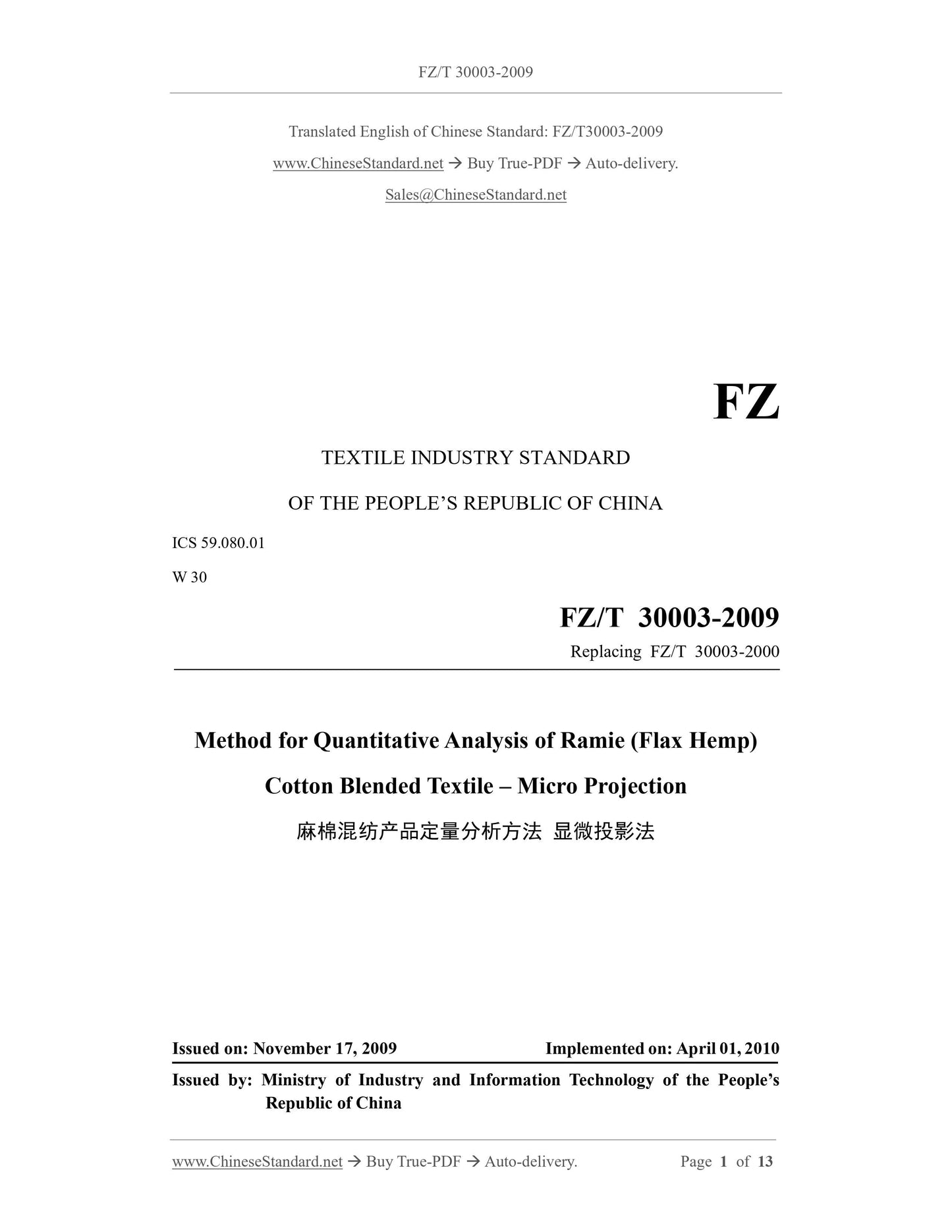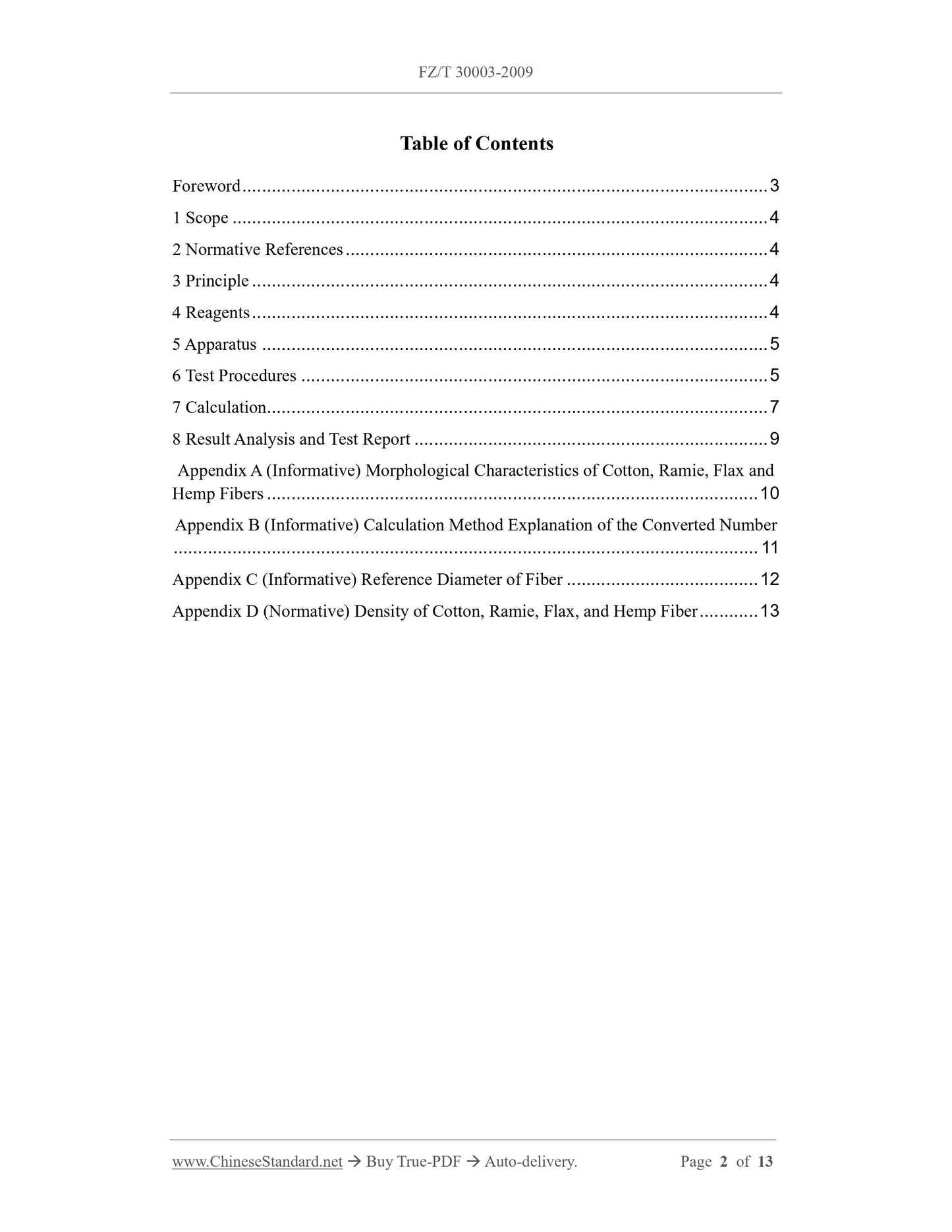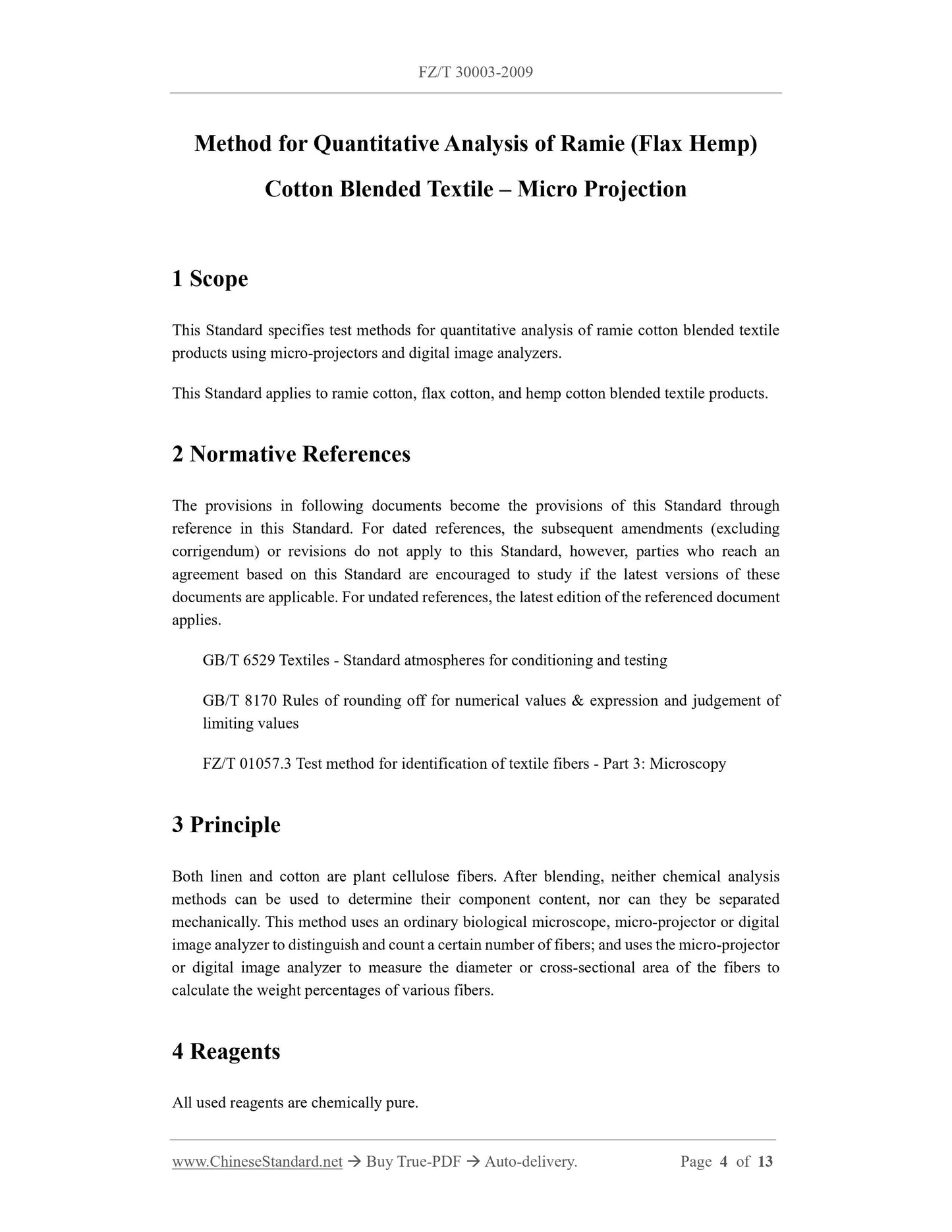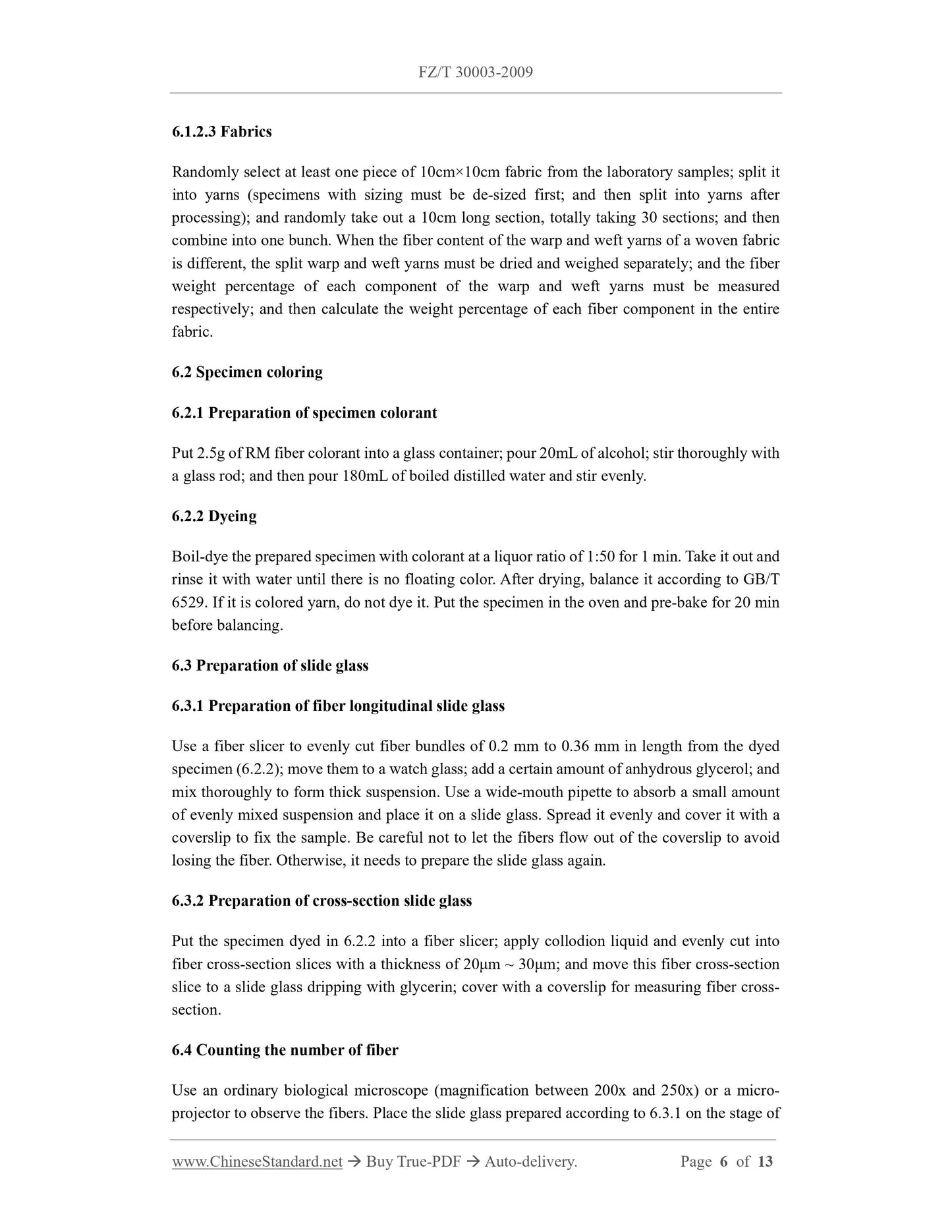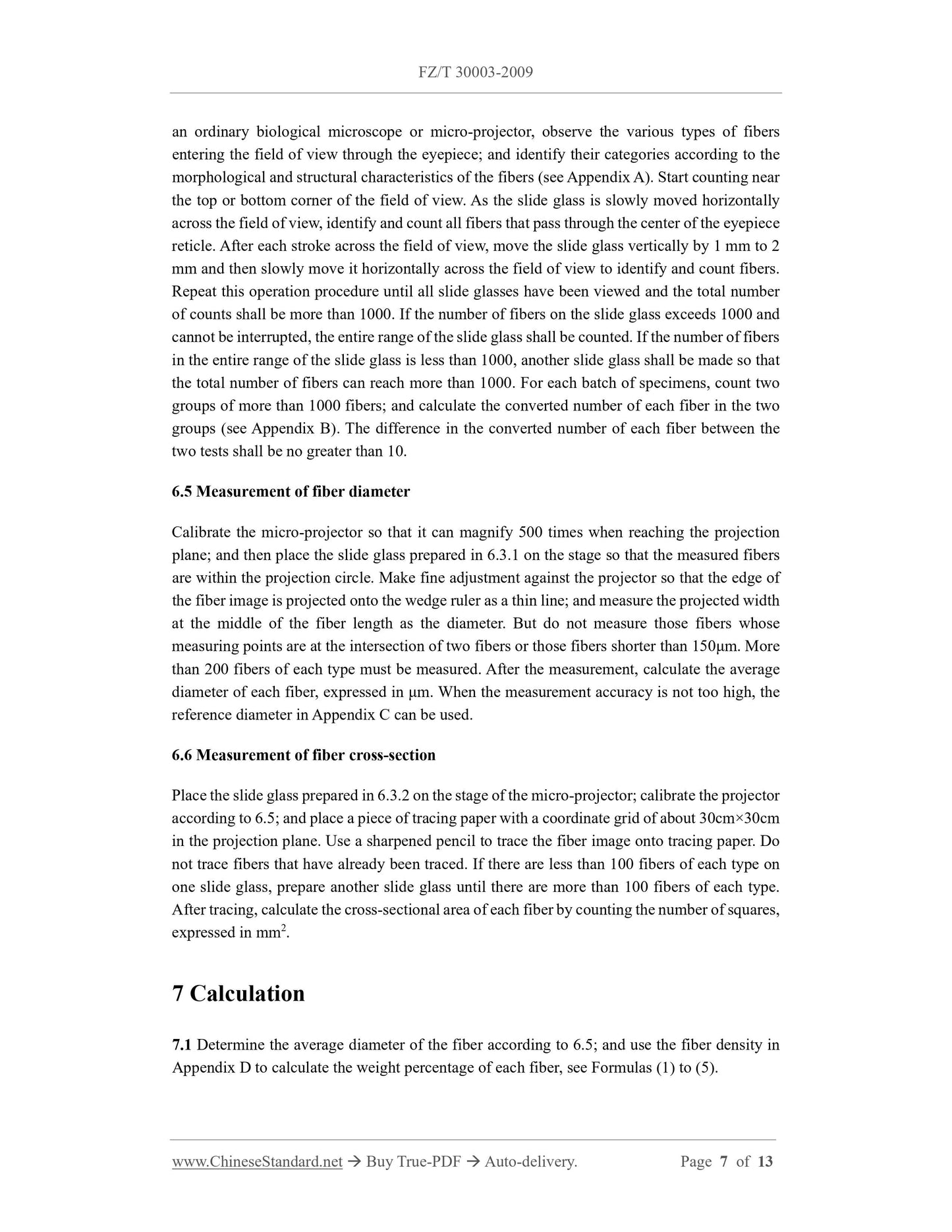1
/
von
5
PayPal, credit cards. Download editable-PDF and invoice in 1 second!
FZ/T 30003-2009 English PDF (FZT30003-2009)
FZ/T 30003-2009 English PDF (FZT30003-2009)
Normaler Preis
$265.00 USD
Normaler Preis
Verkaufspreis
$265.00 USD
Grundpreis
/
pro
Versand wird beim Checkout berechnet
Verfügbarkeit für Abholungen konnte nicht geladen werden
Delivery: 3 seconds. Download true-PDF + Invoice.
Get QUOTATION in 1-minute: Click FZ/T 30003-2009
Historical versions: FZ/T 30003-2009
Preview True-PDF (Reload/Scroll if blank)
FZ/T 30003-2009: Method for quantitative analysis of ramie(flax hemp)cotton blended textile. Micro projection
FZ/T 30003-2009
FZ
TEXTILE INDUSTRY STANDARD
OF THE PEOPLE’S REPUBLIC OF CHINA
ICS 59.080.01
W 30
Replacing FZ/T 30003-2000
Method for Quantitative Analysis of Ramie (Flax Hemp)
Cotton Blended Textile – Micro Projection
ISSUED ON: NOVEMBER 17, 2009
IMPLEMENTED ON: APRIL 01, 2010
Issued by: Ministry of Industry and Information Technology of the People’s
Republic of China
Table of Contents
Foreword ... 3
1 Scope ... 4
2 Normative References ... 4
3 Principle ... 4
4 Reagents ... 4
5 Apparatus ... 5
6 Test Procedures ... 5
7 Calculation... 7
8 Result Analysis and Test Report ... 9
Appendix A (Informative) Morphological Characteristics of Cotton, Ramie, Flax and
Hemp Fibers ... 10
Appendix B (Informative) Calculation Method Explanation of the Converted Number
... 11
Appendix C (Informative) Reference Diameter of Fiber ... 12
Appendix D (Normative) Density of Cotton, Ramie, Flax, and Hemp Fiber ... 13
Method for Quantitative Analysis of Ramie (Flax Hemp)
Cotton Blended Textile – Micro Projection
1 Scope
This Standard specifies test methods for quantitative analysis of ramie cotton blended textile
products using micro-projectors and digital image analyzers.
This Standard applies to ramie cotton, flax cotton, and hemp cotton blended textile products.
2 Normative References
The provisions in following documents become the provisions of this Standard through
reference in this Standard. For dated references, the subsequent amendments (excluding
corrigendum) or revisions do not apply to this Standard, however, parties who reach an
agreement based on this Standard are encouraged to study if the latest versions of these
documents are applicable. For undated references, the latest edition of the referenced document
applies.
GB/T 6529 Textiles - Standard atmospheres for conditioning and testing
GB/T 8170 Rules of rounding off for numerical values and expression and judgement of
limiting values
FZ/T 01057.3 Test method for identification of textile fibers - Part 3: Microscopy
3 Principle
Both linen and cotton are plant cellulose fibers. After blending, neither chemical analysis
methods can be used to determine their component content, nor can they be separated
mechanically. This method uses an ordinary biological microscope, micro-projector or digital
image analyzer to distinguish and count a certain number of fibers; and uses the micro-projector
or digital image analyzer to measure the diameter or cross-sectional area of the fibers to
calculate the weight percentages of various fibers.
4 Reagents
All used reagents are chemically pure.
6.1.2.3 Fabrics
Randomly select at least one piece of 10cm×10cm fabric from the laboratory samples; split it
into yarns (specimens with sizing must be de-sized first; and then split into yarns after
processing); and randomly take out a 10cm long section, totally taking 30 sections; and then
combine into one bunch. When the fiber content of the warp and weft yarns of a woven fabric
is different, the split warp and weft yarns must be dried and weighed separately; and the fiber
weight percentage of each component of the warp and weft yarns must be measured
respectively; and then calculate the weight percentage of each fiber component in the entire
fabric.
6.2 Specimen coloring
6.2.1 Preparation of specimen colorant
Put 2.5g of RM fiber colorant into a glass container; pour 20mL of alcohol; stir thoroughly with
a glass rod; and then pour 180mL of boiled distilled water and stir evenly.
6.2.2 Dyeing
Boil-dye the prepared specimen with colorant at a liquor ratio of 1:50 for 1 min. Take it out and
rinse it with water until there is no floating color. After drying, balance it according to GB/T
6529. If it is colored yarn, do not dye it. Put the specimen in the oven and pre-bake for 20 min
before balancing.
6.3 Preparation of slide glass
6.3.1 Preparation of fiber longitudinal slide glass
Use a fiber slicer to evenly cut fiber bundles of 0.2 mm to 0.36 mm in length from the dyed
specimen (6.2.2); move them to a watch glass; add a certain amount of anhydrous glycerol; and
mix thoroughly to form thick suspension. Use a wide-mouth pipette to absorb a small amount
of evenly mixed suspension and place it on a slide glass. Spread it evenly and cover it with a
coverslip to fix the sample. Be careful not to let the fibers flow out of the coverslip to avoid
losing the fiber. Otherwise, it needs to prepare the slide glass again.
6.3.2 Preparation of cross-section slide glass
Put the specimen dyed in 6.2.2 into a fiber slicer; apply collodion liquid and evenly cut into
fiber cross-section slices with a thickness of 20μm ~ 30μm; and move this fiber cross-section
slice to a slide glass dripping with glycerin; cover with a coverslip for measuring fiber cross-
section.
6.4 Counting the number of fiber
Use an ordinary biological microscope (magnification between 200x and 250x) or a micro-
projector to observe the fibers. Place the slide glass prepared according to 6.3.1 on the stage of
an ordinary biological microscope or micro-projector, observe the various types of fibers
entering the field of view through the eyepiece; and identify their categories according to the
morphological and structural characteristics of the fibers (see Appendix A). Start counting near
the top or bottom corner of the field of view. As the slide glass is slowly moved horizontally
across the field of view, identify and count all fibers that pass through the center of the eyepiece
reticle. After each stroke across the field of view, move the slide glass vertically by 1 mm to 2
mm and then slowly move it horizontally across the field of view to identify and count fibers.
Repeat this operation procedure until all slide glasses have been viewed and the total number
of counts shall be more than 1000. If the number of fibers on the slide glass exceeds 1000 and
cannot be interrupted, the entire range of the slide glass shall be counted. If the number of fibers
in the entire range of the slide glass is less than 1000, another slide glass shall be made so that
the total number of fibers can reach more than 1000. For each batch of specimens, count two
groups of more than 1000 fibers; and calculate the converted number of each fiber in the two
groups (see Appendix B). The difference in the converted number of each fiber between the
two tests shall be no greater than 10.
6.5 Measurement of fiber diameter
Calibrate the micro-projector so that it can magnify 500 times when reaching the projection
plane; and then place the slide glass prepared in 6.3.1 on the stage so that the measured fibers
are within the projection circle. Make fine adjustment against the projector so that the edge of
the fiber image is projected onto the wedge ruler as a thin line; and measure the projected width
at the middle of the fiber length as the diameter. But do not measure those fibers whose
measuring points are at the intersection of two fibers or those fibers shorter than 150μm. More
than 200 fibers of each type must be measured. After the measurement, calculate the average
diameter of each fiber, expressed in μm. When the measurement accuracy is not too high, the
reference diameter in Appendix C can be used.
6.6 Measurement of fiber cross-section
Place the slide glass prepared in 6.3.2 on the stage of the micro-projector; calibrate the projector
according to 6.5; and place a piece of tracing paper with a coordinate grid of about 30cm×30cm
in ...
Get QUOTATION in 1-minute: Click FZ/T 30003-2009
Historical versions: FZ/T 30003-2009
Preview True-PDF (Reload/Scroll if blank)
FZ/T 30003-2009: Method for quantitative analysis of ramie(flax hemp)cotton blended textile. Micro projection
FZ/T 30003-2009
FZ
TEXTILE INDUSTRY STANDARD
OF THE PEOPLE’S REPUBLIC OF CHINA
ICS 59.080.01
W 30
Replacing FZ/T 30003-2000
Method for Quantitative Analysis of Ramie (Flax Hemp)
Cotton Blended Textile – Micro Projection
ISSUED ON: NOVEMBER 17, 2009
IMPLEMENTED ON: APRIL 01, 2010
Issued by: Ministry of Industry and Information Technology of the People’s
Republic of China
Table of Contents
Foreword ... 3
1 Scope ... 4
2 Normative References ... 4
3 Principle ... 4
4 Reagents ... 4
5 Apparatus ... 5
6 Test Procedures ... 5
7 Calculation... 7
8 Result Analysis and Test Report ... 9
Appendix A (Informative) Morphological Characteristics of Cotton, Ramie, Flax and
Hemp Fibers ... 10
Appendix B (Informative) Calculation Method Explanation of the Converted Number
... 11
Appendix C (Informative) Reference Diameter of Fiber ... 12
Appendix D (Normative) Density of Cotton, Ramie, Flax, and Hemp Fiber ... 13
Method for Quantitative Analysis of Ramie (Flax Hemp)
Cotton Blended Textile – Micro Projection
1 Scope
This Standard specifies test methods for quantitative analysis of ramie cotton blended textile
products using micro-projectors and digital image analyzers.
This Standard applies to ramie cotton, flax cotton, and hemp cotton blended textile products.
2 Normative References
The provisions in following documents become the provisions of this Standard through
reference in this Standard. For dated references, the subsequent amendments (excluding
corrigendum) or revisions do not apply to this Standard, however, parties who reach an
agreement based on this Standard are encouraged to study if the latest versions of these
documents are applicable. For undated references, the latest edition of the referenced document
applies.
GB/T 6529 Textiles - Standard atmospheres for conditioning and testing
GB/T 8170 Rules of rounding off for numerical values and expression and judgement of
limiting values
FZ/T 01057.3 Test method for identification of textile fibers - Part 3: Microscopy
3 Principle
Both linen and cotton are plant cellulose fibers. After blending, neither chemical analysis
methods can be used to determine their component content, nor can they be separated
mechanically. This method uses an ordinary biological microscope, micro-projector or digital
image analyzer to distinguish and count a certain number of fibers; and uses the micro-projector
or digital image analyzer to measure the diameter or cross-sectional area of the fibers to
calculate the weight percentages of various fibers.
4 Reagents
All used reagents are chemically pure.
6.1.2.3 Fabrics
Randomly select at least one piece of 10cm×10cm fabric from the laboratory samples; split it
into yarns (specimens with sizing must be de-sized first; and then split into yarns after
processing); and randomly take out a 10cm long section, totally taking 30 sections; and then
combine into one bunch. When the fiber content of the warp and weft yarns of a woven fabric
is different, the split warp and weft yarns must be dried and weighed separately; and the fiber
weight percentage of each component of the warp and weft yarns must be measured
respectively; and then calculate the weight percentage of each fiber component in the entire
fabric.
6.2 Specimen coloring
6.2.1 Preparation of specimen colorant
Put 2.5g of RM fiber colorant into a glass container; pour 20mL of alcohol; stir thoroughly with
a glass rod; and then pour 180mL of boiled distilled water and stir evenly.
6.2.2 Dyeing
Boil-dye the prepared specimen with colorant at a liquor ratio of 1:50 for 1 min. Take it out and
rinse it with water until there is no floating color. After drying, balance it according to GB/T
6529. If it is colored yarn, do not dye it. Put the specimen in the oven and pre-bake for 20 min
before balancing.
6.3 Preparation of slide glass
6.3.1 Preparation of fiber longitudinal slide glass
Use a fiber slicer to evenly cut fiber bundles of 0.2 mm to 0.36 mm in length from the dyed
specimen (6.2.2); move them to a watch glass; add a certain amount of anhydrous glycerol; and
mix thoroughly to form thick suspension. Use a wide-mouth pipette to absorb a small amount
of evenly mixed suspension and place it on a slide glass. Spread it evenly and cover it with a
coverslip to fix the sample. Be careful not to let the fibers flow out of the coverslip to avoid
losing the fiber. Otherwise, it needs to prepare the slide glass again.
6.3.2 Preparation of cross-section slide glass
Put the specimen dyed in 6.2.2 into a fiber slicer; apply collodion liquid and evenly cut into
fiber cross-section slices with a thickness of 20μm ~ 30μm; and move this fiber cross-section
slice to a slide glass dripping with glycerin; cover with a coverslip for measuring fiber cross-
section.
6.4 Counting the number of fiber
Use an ordinary biological microscope (magnification between 200x and 250x) or a micro-
projector to observe the fibers. Place the slide glass prepared according to 6.3.1 on the stage of
an ordinary biological microscope or micro-projector, observe the various types of fibers
entering the field of view through the eyepiece; and identify their categories according to the
morphological and structural characteristics of the fibers (see Appendix A). Start counting near
the top or bottom corner of the field of view. As the slide glass is slowly moved horizontally
across the field of view, identify and count all fibers that pass through the center of the eyepiece
reticle. After each stroke across the field of view, move the slide glass vertically by 1 mm to 2
mm and then slowly move it horizontally across the field of view to identify and count fibers.
Repeat this operation procedure until all slide glasses have been viewed and the total number
of counts shall be more than 1000. If the number of fibers on the slide glass exceeds 1000 and
cannot be interrupted, the entire range of the slide glass shall be counted. If the number of fibers
in the entire range of the slide glass is less than 1000, another slide glass shall be made so that
the total number of fibers can reach more than 1000. For each batch of specimens, count two
groups of more than 1000 fibers; and calculate the converted number of each fiber in the two
groups (see Appendix B). The difference in the converted number of each fiber between the
two tests shall be no greater than 10.
6.5 Measurement of fiber diameter
Calibrate the micro-projector so that it can magnify 500 times when reaching the projection
plane; and then place the slide glass prepared in 6.3.1 on the stage so that the measured fibers
are within the projection circle. Make fine adjustment against the projector so that the edge of
the fiber image is projected onto the wedge ruler as a thin line; and measure the projected width
at the middle of the fiber length as the diameter. But do not measure those fibers whose
measuring points are at the intersection of two fibers or those fibers shorter than 150μm. More
than 200 fibers of each type must be measured. After the measurement, calculate the average
diameter of each fiber, expressed in μm. When the measurement accuracy is not too high, the
reference diameter in Appendix C can be used.
6.6 Measurement of fiber cross-section
Place the slide glass prepared in 6.3.2 on the stage of the micro-projector; calibrate the projector
according to 6.5; and place a piece of tracing paper with a coordinate grid of about 30cm×30cm
in ...
Share
